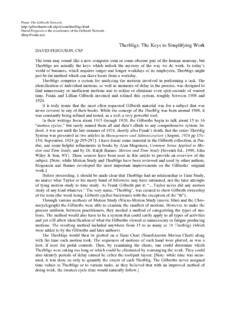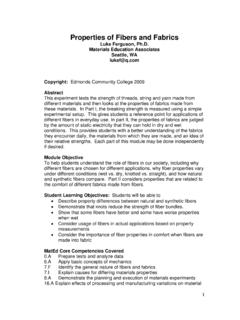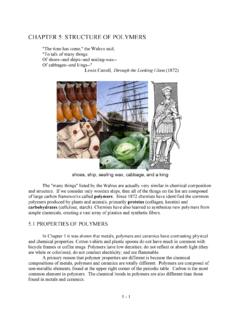Transcription of 5.33 Lecture Notes: Introduction To Polymer Chemistry
1 Lecture Notes: Introduction To Polymer Chemistry Polymer : A large molecule (macromolecule) built up by repetitive bonding (covalent) of smaller molecules (monomers) Generally not a well defined structure, or molecular weight. Need to use statistical properties to describe. Polymers are formed by linking monomers through chemical reaction called polymerization. You don t end up with a unique molecule. i monomers chain of monomers i A (A A A)i/3 Homopolymer: all A identical The most produced/used polymers are homopolymers of terminal alkenes.
2 Produced by radical polymerization. i CH2=CH2 (CH2 CH2)i ethylene polyethylene H C=C2 CHCOOCH33 H C-C 2 CHCOOCH33ii methylmethacrylate PMMA , Introduction to Polymer Chemistry Page 2 Copolymers: made up of different monomers i A + i B (A-B)i H C=CHCl22ii+H C=CCl2 vinyl chloride vinylidene chloride poly(vinylchloride-co-vinylidene chloride)
3 Saran A-B-A-B-A-B alternating copolymer A-A-A-A-B-A-B random copolymer Both of these are rare. Most common is a statistical copolymer, which has a statistical distribution of repeat units. Block copolymers Two long sequences of repeat units A-A-A-A-A-A-A-B-B-B-B-B-B-B AB diblock copolymer AB graft copolymer H C-CH-CH -C 2 CliClCl2.
4 Introduction to Polymer Chemistry Page 3 Structural characteristics Closely related to material properties linear (uninterrupted straight chain) branched (occasional branches off longer chain) networked (many interconnected linear chains; one giant molecule) Stereochemistry of Linkages ISOTACTIC R groups on same side of backbone SYNDIOTACTIC R groups on alternating sides of backbone ATACTIC Random (most common) Ziegler-Natta catalysts used for iso- and syndio- crosslinkbranch pointRHRHRHHRHHRHRHRHHRH , Introduction to Polymer Chemistry Page 4 Classification of polymers.
5 Polymers (synthetic) 1) Thermoplastics (plastics) linear, some cross-linking can be melted and reformed on heating a) Amorphous no ordered structure b) Semi-crystalline composed of microscopic crystallites domains of crystalline structure. Can be ordered. Fibers (nylon, polyester) 2) Elastomers (rubbers) moderately cross-linked can be stretched and rapidly recover their original dimension 3) Thermostats (resins) massively cross-linked very rigid.
6 Degrade on heating 4) Dendrimers multiply branched multiple consecutive (regular) branches Biopolymers polypeptides proteins-amino acid heteropolymer nucleic acids RNA/DNA polysaccharides sugars , Introduction to Polymer Chemistry Page 5 Characterization 1) How do polymers respond to an applied force? (study of flow and deformation: rheology) An elastic medium is described by Newton s Law: Fkx= If you apply a force (a stress), the material displaces by an amount x: Fxk= small k: weak spring easily displaced big K: stiff spring difficult to displace Polymers are often non-Newtonian For polymers, we apply a stress, and it leads to internal distortion strain.
7 = m S strainshear small m stretches easily/compresses easily (rubber) large m small strain produced by stress (hard plastics PMMA) viscoelastic medium stress elastic modulus strain displacement F xFxksmallkbigFx , Introduction to Polymer Chemistry Page 6 The elastic modulus m is highly temperature dependent!
8 Rubber has small m at room temperature ball bounces At low T, m much larger rubber ball in liquid N2 shatters when bounced hard plastic Also, plastics heated above room temperature are less stiff. TYPICAL PLOT OF m(T) Tlog mplasticrubberresinTgTdegradationTmelt Where is room temperature on this plot? (depends on whether you have a rubber or plastic) The various temperatures characterize polymers. , Introduction to Polymer Chemistry Page 7 2) Molecular Weight Molar Mass (M) i: degree of polymerization (# of monomer units) 0iMiM= Mi : molar mass of Polymer molecule i M0.
9 Molecular weight of monomer Typically have distribution of masses (all chain lengths aren t equally long) monodisperse equal chain lengths purified proteins, dendriners polydisperse unequal lengths Characterize the polydispersity through F(Mi): distribution of molar masses. MiF(Mi)nMwMvM We can find several statistical ways of describing the molar mass. Comparison of these numbers helps describe F(M).
10 A) Number-average molar mass, nM ()()00iiiniiNMMFMdMMNFMdM = (first moment) Ni: # of molecules with degree of polymerization i Mi: molar mass for degree of polymerization I , Introduction to Polymer Chemistry Page 8 B) Mass- or Weight-average molar mass, wM wiiiMwM= wi is the weight fraction: the total mass of molecules with mass Mi divided by the total mass of all molecules iiiiiiNMwNM= ()()2200iiiwiiiNMFMMdMMNMFMMdM = (second moment of ) C) In experiment 4, we are studying viscosity-average molar mass, vM ()()()100aavMFMdMMFMdM + = Polydispersity We can describe the polydispersity through the width of the distribution of molar masses.















